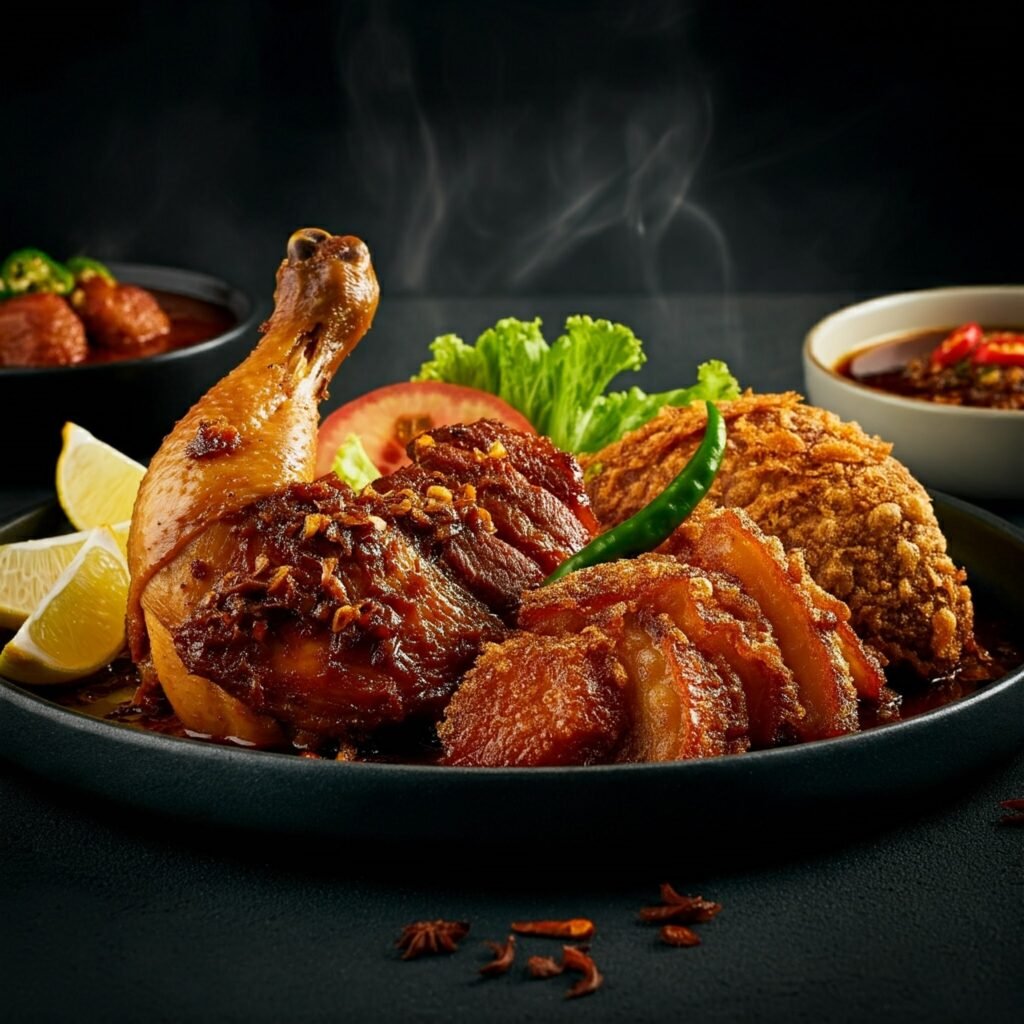Maayong adlaw, mga kaibigan! Welcome to Maya’s Kitchen Tales, where we’re about to embark on a mouthwatering journey through the heart of Filipino cuisine. Today, we’re diving deep into the world of adobo – that iconic dish that’s as diverse as our beautiful archipelago. Grab your aprons and let’s explore the delicious realm of Adobo All-Stars!
The Adobo Legacy: A Taste of Home
When I close my eyes and think of home, the first aroma that wafts through my memories is the tangy, garlicky scent of adobo simmering on my Lola’s old stove. It’s a smell that wraps around you like a warm hug, promising comfort and satisfaction with every bite. But here’s the thing about adobo – it’s not just one dish. It’s a whole universe of flavors, each version telling its own story of family, region, and tradition.
Adobo, in its essence, is a cooking method. The word itself comes from the Spanish “adobar,” meaning to marinate. But oh, how we Filipinos have taken this concept and run with it! From the vinegar-soaked streets of Manila to the coconut groves of Bicol, every region, every family has their own spin on this beloved classic.
The Adobo Basics: Building Blocks of Flavor
Before we dive into the exciting variations, let’s break down the basics. A traditional adobo typically includes these key elements:
| Ingredient | Purpose |
|---|---|
| Meat (usually pork or chicken) | The star of the show |
| Vinegar | Provides tang and acts as a preservative |
| Soy sauce | Adds saltiness and umami |
| Garlic | Offers aromatic punch |
| Black peppercorns | Brings a subtle heat |
| Bay leaves | Contributes earthy notes |
These ingredients come together in a harmonious dance, creating that signature adobo flavor we all know and love. But remember, mga kaibigan, recipes are guidelines, not rules. The beauty of adobo lies in its adaptability!
Regional Adobo Adventures: A Culinary Road Trip
Now, let’s take a gastronomic tour of the Philippines through its adobo variations. Buckle up – it’s going to be a delicious ride!
Adobong Puti (White Adobo)
Our first stop is in certain parts of Luzon, where Adobong Puti reigns supreme. This version skips the soy sauce, relying solely on vinegar, salt, and a generous amount of garlic for its flavor profile. The result? A lighter-colored dish with a sharper, more pronounced tang.
I remember the first time I tasted Adobong Puti at a food festival in Pampanga. The clean, bright flavors danced on my tongue, making me realize how diverse our national dish truly is. It’s like tasting adobo for the first time all over again!
Adobong Dilaw (Yellow Adobo)
Traveling south to the Visayas, we encounter Adobong Dilaw. This golden beauty gets its sunny hue from turmeric, known locally as luyang dilaw. The turmeric not only adds color but also imparts a subtle earthy flavor and aroma.
Fun fact: Turmeric is known for its anti-inflammatory properties, making this version of adobo not just delicious but also potentially beneficial for your health!
Adobong Gata (Coconut Milk Adobo)
As we reach the lush region of Bicol, famous for its love affair with coconuts, we discover Adobong Gata. This creamy variation adds coconut milk to the mix, resulting in a richer, more indulgent adobo experience.
The first time I tried making Adobong Gata at home, the aroma of coconut milk simmering with vinegar and soy sauce filled my kitchen, transporting me straight to the coconut-lined beaches of Bicol. It’s like a tropical vacation in a pot!
Protein Parade: Beyond Pork and Chicken
While pork and chicken are the most common proteins used in adobo, the possibilities are endless. Let’s explore some unique variations:
Adobong Pusit (Squid Adobo)
For seafood lovers, Adobong Pusit is a must-try. The squid is cooked in the classic adobo sauce, with its ink creating a striking black color. This dish is a testament to our archipelagic nature, celebrating the bounty of our seas.
Cooking tip: Be careful not to overcook the squid, or it may become rubbery. A quick high-heat cook is all you need for tender, flavorful Adobong Pusit.
Adobong Itlog (Egg Adobo)
Who says adobo has to be meaty? Adobong Itlog is a vegetarian-friendly version that uses hard-boiled eggs as the protein. The eggs soak up the flavorful sauce, creating little pockets of adobo goodness.
I love making Adobong Itlog when I’m short on time but craving that adobo flavor. It’s quick, easy, and oh-so-satisfying!
Adobong Kangkong (Water Spinach Adobo)
For a verdant twist, try Adobong Kangkong. This leafy green vegetable, also known as water spinach, is stir-fried with garlic and chili, then simmered in adobo sauce. It’s a great way to get your greens while still enjoying that classic adobo taste.
The Adobo Matrix: Mix and Match for Endless Possibilities
One of the most exciting things about adobo is its versatility. You can mix and match ingredients to create your own signature adobo. Here’s a simple matrix to help you build your perfect adobo:
| Base | Protein | Additional Flavoring | Cooking Method |
|---|---|---|---|
| Vinegar + Soy Sauce | Pork | Coconut Milk | Braising |
| Vinegar Only | Chicken | Turmeric | Frying then Braising |
| Vinegar + Coconut Milk | Squid | Chili | Simmering |
| Balsamic Vinegar | Tofu | Pineapple | Slow Cooking |
The possibilities are endless! Don’t be afraid to experiment and find your own adobo groove.
Adobo Innovations: Modern Twists on a Timeless Classic
As much as we love our traditional adobo, it’s exciting to see how modern Filipino chefs are reinterpreting this classic dish. Here are some innovative adobo creations that have caught my eye (and taste buds):
Adobo Paella
Imagine the flavors of adobo infused into a Spanish paella. This fusion dish combines the best of both worlds – the savory, tangy notes of adobo with the crispy bottom (tutong) of paella. It’s a testament to our shared culinary history with Spain, reimagined for the modern palate.
Adobo Burger
For a handheld adobo experience, try an adobo burger. Shredded adobo meat is mixed with melted cheese and sandwiched between soft buns. It’s street food meets home cooking, and it’s absolutely delicious!
Adobo Ice Cream
Yes, you read that right! Some innovative ice cream makers have created adobo-flavored ice cream. The savory-sweet combination might sound strange, but don’t knock it until you’ve tried it. It’s a perfect example of how versatile adobo flavors can be.
The Adobo Advantage: Health Benefits and More
Beyond its incredible taste, adobo also offers some health benefits:
- Garlic Power: The generous use of garlic in adobo provides antioxidants and may help boost the immune system.
- Vinegar Magic: The vinegar in adobo not only acts as a preservative but may also aid in digestion and help regulate blood sugar levels.
- Protein Punch: Whether you choose pork, chicken, or a plant-based protein, adobo provides a good source of protein for muscle health.
- Versatile Veggies: Variations like Adobong Kangkong add nutritious vegetables to your diet.
Adobo Around the World: A Filipino Ambassador
Adobo isn’t just beloved within the Philippines – it’s gaining recognition worldwide as a representative of Filipino cuisine. From food trucks in Los Angeles to high-end restaurants in London, adobo is introducing global palates to the complex flavors of Philippine cooking.
I once had the pleasure of demonstrating how to make adobo at a food festival in Singapore. The attendees were fascinated by the simplicity of the ingredients and the depth of flavor achieved. It was a proud moment, sharing a piece of our culinary heritage with the world.
The Adobo Challenge: Create Your Signature Adobo
Now that we’ve explored the wonderful world of adobo, I challenge you, dear readers, to create your own signature adobo dish. Here’s a simple framework to get you started:
- Choose your protein: Will it be the classic pork or chicken? Or something unconventional like tofu or jackfruit?
- Select your base: Traditional vinegar and soy sauce, or will you experiment with coconut milk or even fruit juices?
- Pick your add-ins: Garlic and peppercorns are classic, but how about adding lemongrass, chili, or even a dash of fruit preserve for sweetness?
- Decide on your method: Will you braise, fry then simmer, or perhaps try slow-cooking your adobo?
Remember, there’s no “wrong” way to make adobo. The best adobo is the one that makes your taste buds sing and your heart feel at home.
Adobo: More Than Just a Dish
As we come to the end of our adobo journey, I’m reminded that adobo is more than just a dish – it’s a reflection of who we are as Filipinos. It’s adaptable, resilient, and full of flavor, just like our people. It tells the story of our history, our geography, and our love for good food shared with family and friends.
Whether you’re cooking up a traditional adobo recipe passed down through generations, or experimenting with a modern fusion twist, remember that you’re partaking in a rich culinary tradition. Every pot of adobo bubbling on the stove is a celebration of Filipino culture and creativity.
So, mga kaibigan, the next time you’re in the kitchen, why not whip up a batch of adobo? Experiment with the flavors, make it your own, and most importantly, share it with the people you love. After all, that’s what Filipino cooking is all about – nurturing bonds and creating memories, one delicious dish at a time.
Salamat sa pagbabasa, and happy cooking!
Disclaimer: While every effort has been made to ensure the accuracy of the information in this blog post, cooking methods and ingredient preferences can vary widely. The author encourages readers to adapt recipes to their personal tastes and dietary needs. If you notice any inaccuracies or have suggestions for improvement, please don’t hesitate to reach out. We value your feedback and are committed to providing the most reliable and enjoyable content possible.





Fantastic post however I was wondering if you could write a litte more on this topic? I’d be very grateful if you could elaborate a little bit further. Cheers!